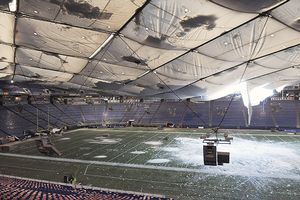MINNEAPOLIS -- The landlords of the Metrodome voted unanimously Thursday to replace the snow-damaged roof of the venerable stadium, opting for a more time-consuming fix that could disrupt the Minnesota Vikings' preseason schedule.
The Metropolitan Sports Facilities Commission approved a recommendation from engineers who said they worried simply repairing several torn panels of the stadium's Teflon roof wouldn't be enough to prevent another failure.
[+] Enlarge

Hannah Foslien/Getty ImagesA torn section of the roof sags inside the Hubert H. Humphrey Metrodome on December 13. The landlords of the Metrodome voted unanimously Thursday to replace the snow-damaged roof.
Work could get underway by the middle of March with a goal of finishing by Aug. 1, at an estimated cost of $18.3 million. Dome officials said all but a $25,000 deductible will be covered by insurance. The NFL's preseason schedule hasn't been released, but the Vikings could be affected if the roof work takes longer than the commission hopes.
In a statement, the Vikings said they support the roof replacement but said it "is not a long-term stadium solution" for them. The team is pursuing state legislation to pay for and build a new stadium, and lawmakers at the Capitol are readying a bill that could debut this month.
Vikings vice president Lester Bagley said the team has talked to the University of Minnesota about playing a couple exhibition games at TCF Bank Stadium if the new roof isn't ready.
The Metrodome roof collapsed in the early morning hours of Dec. 13, at the tail end of a snowstorm that pounded the region for about 24 hours straight. TV cameras captured footage of the roof giving way and snow pouring onto the field.
It was the fourth time in the Metrodome's nearly 30-year history that heavy snow had caused the roof to fall, but the most recent collapse was 27 years ago. Metrodome officials initially hoped to get the tears repaired quickly, but difficult weather conditions made the job dangerous and ultimately forced the Vikings to move their last two home games of the season.
A game against the New York Giants scheduled for that Sunday was postponed a day and played in Detroit, and a game against Chicago was moved to TCF Bank Stadium, making it the Vikings' first outdoor home game in 30 years. They lost both games.
Engineers wrote the full replacement of the 10-acre roof was the only way to guard against another deflation from defects they might not have found. Several panels ripped under the weight of the snow, but many others appeared undamaged.
"We would not be able to certify that the roof membrane meets industry standard levels of safety without a complete replacement of the roof membrane," one firm, Walter P. Moore and Associates, said in a report.
Another firm, Geiger Engineers, rated the probability of such defects dooming the roof again as "very high."
Metrodome officials said the engineers needed several weeks to make the recommendation because of dangerous conditions on the roof. Engineers said much of the worst damage to the roof has come since the collapse, as it shifts under large piles and pools of snow, ice and water.
"Basically what you have up there is a glacier that's continually moving around and creasing the roof," said Ted Mondale, chairman of the Sports Facilities Commission.
Several planned events have been canceled since the roof collapse, including hundreds of college baseball games, an ethnic New Year celebration and a monster truck rally. Metrodome officials said business interruption insurance should help cover lost revenue from canceled events.
The collapse pushed questions about the Vikings' future in Minnesota to the forefront. The team already had been scheduled to play the final season of its Metrodome lease in 2011 and has been pushing for a new stadium for a while, saying its longtime home is not profitable enough for the team and lacks fan amenities. But the state's projected $6.2 billion budget deficit has complicated the lobbying effort.
State lawmakers have promised to bring forward a stadium bill soon that would include a proposed site. There appears to be up to four options, including where the Metrodome now sits near downtown Minneapolis. Two other sites in Minneapolis are under consideration, and several commissioners in next-door Ramsey County are preparing a push for a former ammunition plant site in Arden Hills, north of St. Paul.
Tony Bennett, the commissioner pushing Arden Hills, said he envisions county taxpayers contributing at some level. Vikings executives have toured the site and met with county officials, and Bagley said Thursday the team sees the site as "promising." At the same time, he said, the current site of the Metrodome would be most cost-effective.
The Vikings have said they would pay about one-third of the cost of building a roofless stadium. Gov. Mark Dayton and most lawmakers have said they prefer a more expensive roofed or retractable-roof stadium that would be more versatile.
Dayton repeated Thursday in an interview with Minnesota Public Radio that he believes the Vikings should pay for at least a third to one-half of a stadium tab estimated to reach at least $700 million. Dayton said he believes the state's share should come from stadium users through fees on purchases such as food and gear or through taxes on hotels and rental cars near the new stadium.
Mondale said the commission never considered not going ahead with the roof replacement even though the Vikings have vowed to leave the Metrodome.
"We've been paying those insurance bills for a reason," Mondale said.
Copyright 2011 by The Associated Press





